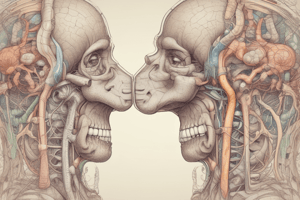Podcast
Questions and Answers
Which structure connects the throat to the bronchi?
Which structure connects the throat to the bronchi?
- The bronchioles
- The trachea (correct)
- The nasal cavities
- The pulmonary alveolus
What type of epithelium lines the nasal cavities?
What type of epithelium lines the nasal cavities?
- Simple cuboidal epithelium
- Stratified squamous epithelium
- Transitional epithelium
- Ciliated pseudostratified columnar epithelium (correct)
Olfactory glands in the nasal cavities secrete what type of substance?
Olfactory glands in the nasal cavities secrete what type of substance?
- Proteinaceous substance (correct)
- Mucus
- Aqueous solution
- Hormones
What do the bronchioles eventually end in?
What do the bronchioles eventually end in?
What type of cells contain proteins that act as odorant receptors?
What type of cells contain proteins that act as odorant receptors?
Study Notes
Lower Respiratory Tract
- The trachea connects the throat to the bronchi.
- The bronchi divide into two tubes.
- Bronchioles are smaller tubes that branch off from the bronchi and end in the pulmonary alveolus.
- The lung structure consists of the bronchial tree, which includes air tubes branching off from the bronchi into smaller and smaller air tubes, each ending in a pulmonary alveolus.
Nasal Cavities
- The nasal cavities are lined with a ciliated pseudostratified columnar epithelium.
- This epithelium contains the cell bodies of bipolar nerve (olfactory) cells that have proteins acting as odorant receptors.
Mucosa of the Nasal Cavities
- The mucosa of the nasal cavities has olfactory nerves.
- It also has olfactory glands that secrete a proteinaceous substance onto the epithelial surface.
- This secretion keeps the surface moist and provides a trap for aromatic substances.
Studying That Suits You
Use AI to generate personalized quizzes and flashcards to suit your learning preferences.
Description
Learn about the structures and functions of the lower respiratory tract, including the trachea, bronchi, bronchioles, and pulmonary alveolus, as well as the nasal cavities.




